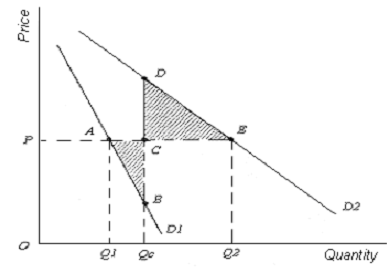Welfare Gains of Decentralization:
Now the welfare gains of citizens from a decentralized public choice will be maximized, following Tiebout, is shown in Figure. For example, the population of a nation is divided into two groups. For simplicity it may be assumed that the demand curve for the public good is identical for all individuals in each of the groups. At the same time it is further assumed that the demand differs between the two groups. So, D1 is the demand curve of the individuals in group I and D1 is the demand curve of group II. The other assumption is that constant cost conditions prevail with regard to the supply of public good. Under these conditions, the preferred levels of public good for people in group I group II are Q1and Q2 respectively as shown in the figure. But in a centralized system of government a single uniform level of public service would be provided, Qc in the figure. At this level of output, the welfare loss to individuals of group I equals the shaded area ABC. This shows the excess costs incurred by the individuals over their valuation of excessive units of consumption of Q1Qc. Similarly, the welfare loss to group II is equivalent to the area represented by CDE.

Of course, there are number of qualifications that are to be observed in this context. Firstly, the extent of loss of welfare depends upon the degree of homogeneity of individual preferences. Secondly, the quantum of loss of consumer surplus varies inversely with the price elasticity of demand. Thirdly, the unit cost becomes lower to larger communities than for smaller ones if there exists economies of scale in the production. In essence, the size of welfare losses depends upon the distribution of preferences of the whole community, the elasticity of demand and the existence of economies of scale. Undoubtedly, decentralization will bring efficiency gains in a federation. So let us know more about the economic advantages of decentralization or of the sub-central governments.